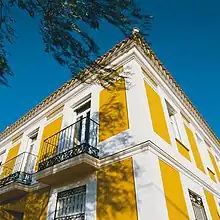
Algaecide or algicide is a biocide used for killing and preventing the growth of algae, often defined in a loose sense that, beyond the biological definition, also includes cyanobacteria ("blue-green algae").[1] An algaecide may be used for controlled bodies of water (reservoirs, golf ponds, swimming pools), but may also be used on land for locations such as turfgrass.[2]
Types
Inorganic compounds
Some inorganic compounds are known since antiquity for their algicidal action due to their simplicity.
- Copper(II) sulfate remains "the most effective algicidal treatment".[3] A related traditional use is the Bordeaux mixture, used to control fungus on fruits.[4]
- Hydrated lime, as a biocide, is allowed in the production of organic foods.[5]
Barley straw
Barley straw, in England, is placed in mesh bags and floated in fish ponds or water gardens to help reduce algal growth without harming pond plants and animals. Barley straw has not been approved by the United States Environmental Protection Agency (EPA) for use as a pesticide and its effectiveness as an algaecide in ponds has produced mixed results during university testing in the United States and England. It is unclear how straw actually works.[6]

Synthetic algicides
Synthetic algicides include:
- benzalkonium chloride – "quat" disinfectant that attacks membranes
- bethoxazin – "new broad spectrum industrial microbicide" in 2012,[7] noted as "Canceled in U.S." in 2022 PubChem-EPA query[8]
- cybutryne – banned since 2023 in ship paint[9]
- dichlone – quinone fungicide/algaecide, not persistent in soil
- dichlorophen – also kills invertebrate animals and bacteria
- diuron – herbicide/algaecide, inhibits photosynthesis
- endothal – herbicide/algaecide, inhibits protein phosphatase 2A
- fentin – quinone fungicide/algaecide, discontinued
- isoproturon – selective substituted urea herbicide, discontinued
- methabenzthiazuron – substituted urea herbicide, discontinued
- nabam – fungicide/algicide discontinued in the EU over cancer
- oxyfluorfen – herbicide, "very toxic to aquatic life with long lasting effects"[10]
- pentachlorophenyl laurate
- quinoclamine – herbicide/algicide, not used in most of the EU[11]
- quinonamid
- simazine – herbicide/algaecide, inhibits photosynthesis
- terbutryn
- Tiodonium
References
- ↑ "Algae in Turf". NC State Extension Publications.
- ↑ "Stomping out algae". Golf Course Industry.
- ↑ Van Hullebusch, E.; Chatenet, P.; Deluchat, V.; Chazal, P. M.; Froissard, D.; Lens, P. N.L.; Baudu, M. (2003). "Fate and forms of Cu in a reservoir ecosystem following copper sulfate treatment (Saint Germain les Belles, France)". Journal de Physique IV (Proceedings). 107: 1333–1336. doi:10.1051/jp4:20030547.
- ↑ Martin, Hubert (1933). "Uses of Copper Compounds: Copper Sulfate's Role in Agriculture". Annals of Applied Biology. 20 (2): 342–363. doi:10.1111/j.1744-7348.1933.tb07770.x. Archived from the original on 2013-09-07. Retrieved 2007-12-31.
- ↑ Pesticide Research Institute for the USDA National Organic Program (23 March 2015). "Hydrated Lime: Technical Evaluation Report" (PDF). Agriculture Marketing Services. Retrieved 17 July 2019.
- ↑ "Barley Straw for Algae Control". PennState Extension. January 22, 2013. Retrieved 3 December 2022.
- ↑ Chee, GL; Bhattarai, B; Daniel Gietz, R; Alrushaid, S; Nitiss, JL; Hasinoff, BB (15 February 2012). "Chemical reactivity and microbicidal action of bethoxazin". Bioorganic & Medicinal Chemistry. 20 (4): 1494–501. doi:10.1016/j.bmc.2011.12.051. PMID 22264763.
- ↑ "Bethoxazin". pubchem.ncbi.nlm.nih.gov.
- ↑ "International Maritime Organization bans toxic paint substance cybutryne". www.bimco.org.
- ↑ "Substance Information - ECHA". echa.europa.eu.
- ↑ Hertfordshire, University of. "Quinoclamine". sitem.herts.ac.uk.
External links
- National Pesticide Information Center (NPIC) Information about pesticide-related topics.